Back to Journals » Diabetes, Metabolic Syndrome and Obesity » Volume 14
Caregivers’ Nutrition Knowledge and Dietary Intake of Type 1 Diabetic Children Aged 3–14 Years in Uganda
Authors Ndahura NB , Munga J, Kimiywe J, Mupere E
Received 30 October 2020
Accepted for publication 7 January 2021
Published 14 January 2021 Volume 2021:14 Pages 127—137
DOI https://doi.org/10.2147/DMSO.S285979
Checked for plagiarism Yes
Review by Single anonymous peer review
Peer reviewer comments 2
Editor who approved publication: Prof. Dr. Antonio Brunetti
Nicholas Bari Ndahura,1,2 Judith Munga,2 Judith Kimiywe,2 Ezekiel Mupere3
1Department of Human Nutrition and Home Economics, Kyambogo University, Kampala, Uganda; 2Department of Food, Nutrition and Dietetics, Kenyatta University, Nairobi, Kenya; 3Department of Pediatrics and Child Health, Makerere University, Kampala, Uganda
Correspondence: Nicholas Bari Ndahura
Department of Human Nutrition and Home Economics, P.O Box 1 Kyambogo, Kampala, Uganda
Tel +256772636271
Email [email protected]
Purpose: This study aimed to assess the association between caregiver’s level of type 1 diabetes (T1D) nutrition knowledge with children’s dietary diversity score (DDS), mean intake of macronutrients, nutrient adequacy ratios (NARs) and mean adequacy ratio (MAR).
Research Design and Methods: A cross-sectional analytical study design was used. The study was conducted at 6 diabetes clinics in Uganda among 59 caregivers and 61 children. T1D nutrition knowledge survey (NKS) was used to assess the caregiver’s nutrition knowledge, and the 24-hour dietary recall and dietary diversity score (DDS) questionnaires were used to collect data on the child’s dietary intake.
Results: Majority (93.2%) of the caregivers had low T1D nutrition knowledge. Carbohydrate counting was the least performed nutrition knowledge domain. The children’s mean DDS, calorie intake and MAR were 5.7 ± 1.6, 666.7 ± 639.8 kcal and 0.7 ± 0.3, respectively. The mean NARs of carbohydrate, protein, and fat were 0.9 ± 0.3, 0.9 ± 0.4, 0.5 ± 0.5, respectively. There was a significant association between DDS with NARs of carbohydrate, protein, fat, vitamins A, B2, B3, B5, B12, folic acid, zinc and MAR. No formal education was significantly associated with a lower mean NKS score among caregivers (p = 0.039). Caregivers’ T1D nutrition knowledge, age and family size explained 14% of variation in the child’s dietary diversity (p = 0.041).
Conclusion: Despite poor nutrition knowledge among caregivers especially on carbohydrate counting, dietary diversity among children with T1D remained favorable. Excess carbohydrate intake was observed with inadequate intake of proteins, fats and micronutrients (vitamin A, B vitamins and calcium). Caregivers with low education were more likely to register poor nutrition knowledge; therefore, there is need to develop and tailor nutrition education programmes to enhance comprehensive learning among caregivers for improved outcomes.
Keywords: nutrition education, type 1 diabetes, nutrient intake, diabetes, adolescents
Introduction
Type 1 diabetes (T1D) is on the increase and it is estimated globally that over 600,000 children aged 0–14 years have T1D with over 90,000 new cases per year.1 Incidence or prevalence data on T1D in Uganda is lacking. However, data from some T1D clinics indicate enrolment of over 1000 T1D patients that have an increasing trend.2 Management of T1D involves a multifaceted assortment of daily tasks and requires collaboration with the caregiver.3,4 Children with T1D often depend on the assistance of caregivers to help them implement their diabetes care tasks.5,6 A caregiver’s knowledge on T1D in particular, nutritional management is crucial in helping children maintain good metabolic control and ensure proper healthy development.7 However, in many economically disadvantaged countries such as Uganda access to structured nutrition education can be limited, contributing to poorly controlled diabetes in children with T1D.8
The influence of parental/caregiver knowledge on children’s adherence to diabetes care behaviors and recommendations has been documented by several studies.5 A facility-based study conducted in Uganda found that caregivers with low knowledge about diabetes did not adhere to diabetes care and management recommendations; however, this study did not consider dietary practices.9 Another study conducted in Tanzanian caregivers reported a significant association between diabetes knowledge and glycated hemoglobin (HbA1c) levels.10 In Kenya, another study established that the nutritional knowledge level among caregivers was significantly associated with the dietary practices of their children.11 A Ghanaian study also reported a positive effect of caregiver feeding behaviors on their children’s nutritional outcomes.12 A study conducted among pediatric patients with T1D showed an association between caregiver nutrition knowledge and improved glycaemic control.13 However, no study has been conducted to investigate the relationship between the dietary intake of children with T1D and type 1 diabetes nutrition knowledge of the caregivers. Our study, therefore, focused on the caregiver’s level of T1D nutrition knowledge and its association with children’s dietary diversity score (DDS), intake of energy, protein, and fat, nutrient adequacy ratio (NAR) and mean adequacy ratio (MAR) in selected diabetes clinics in Uganda. We hypothesized that the caregiver’s level of T1D nutrition knowledge would be associated with children’s DDS and children’s mean intake of macronutrients, NARs and MAR.
Research Design and Methods
Study Setting and Design
A cross-sectional analytical study was conducted from July to December 2019 at six diabetes clinics in Uganda. This study was embedded in a cluster-randomized trial that aims to determine the effectiveness of a nutrition education package on glycaemic control among children with T1D aged 3–14 years in Uganda.14 Caregiver-child dyads were consecutively recruited during routine clinic visits with the assistance of the diabetes nurse specialists based at the clinics. A caregiver was defined as the individual who provided unpaid daily care including feeding most of the time. All caregiver-child dyads aged 3–14 years that had been enrolled in the diabetes clinics for more than 6 months and consented and assented were recruited in the study. A total of 59 caregivers and 61 children were recruited.
Data Collection and Measurements
A structured questionnaire was used to collect information on socio-demographic information (age, sex, relation to child, marital status, occupation, level of education, family size) and type 1 diabetes related characteristics such as insulin use, disease duration and family history of T1D. The type 1 diabetes nutrition knowledge survey (NKS) questionnaire was adopted, Ugandan contextualized and used to assess the caregiver’s level of specific and general diabetes nutrition knowledge based on four domains, namely carbohydrate counting, healthful eating, nutrition label reading and blood glucose response to food.15 The results of the NKS were scored based on the percentage of correct answers ranging from 0% to 100% with a higher percentage indicating better nutrition knowledge. The 24-hour dietary recall was used to collect quantitative information for nutrient adequacy assessment in reference to energy, protein, fat, Vitamins (A, B1, B2, B3, B5, B6, B12), biotin, folic acid, calcium, iron and zinc. Volumetric vessels and household measures such as cups, spoons and plates were used to help the study participants correctly estimate the amount of food and drink consumed.16,17
The 9-food group dietary diversity questionnaire was used to collect information on the variety of foods consumed by the study participants basing on the 24-hour dietary recall.18 The 9 food groups considered included starchy staples (cereals, roots, tubers), vitamin A rich fruits and vegetables, other fruits, other vegetables, legumes, nuts and seeds, oils and fats, meat, poultry and fish, milk and milk products, eggs.19 Study participants whose dietary intake included mixed dishes, individual ingredients were matched to a food group for a score of 1, each food group was only counted once, and the total number of food groups tallied to give the dietary diversity score. To determine the minimum DDS, a cut-off of at least 4 out of the 9 food groups was considered.18,20,21
Ethical Considerations
The study was conducted in accordance with the Declaration of Helsinki. Study participants were informed of the purpose of the study, voluntary participation, withdrawal privilege and confidentiality. Written informed consent and assent were obtained from the caregivers and the children, respectively. Ethics approval was obtained from St. Francis Hospital Nsambya Review and Ethics Committee (reference number: SFHN/REC/83) and a research permit obtained from the Uganda National Council of Science and Technology (reference number: HS186ES).
Data Analysis
Demographic and type 1 diabetes related characteristics of the participants were summarized with frequencies and percentages for categorical variables and means and standard deviations for continuous variables using IBM SPSS Statistics for Macintosh, Version 26.22 Continuous variables were tested for normality using the Kolmogorov–Smirnov statistic. An independent sample t-test was applied to analyze normally distributed data such as sex of caregiver and NKS scores. Mann–Whitney U-test was applied to analyze data that violated normality such as DDS. ANOVA was used to test whether there were significant differences in the mean NKS scores based on caregivers’ level of education and age distribution. Spearman’s rank correlation coefficient was used to test for correlation between caregiver’s level of type 1 diabetes nutrition knowledge and DDS, NAR, and MAR.
To establish the socio-demographic correlates of caregivers’ level of type 1 diabetes nutrition knowledge (measured as NKS scores) and child’s dietary diversity (measured as DDS) simple linear regression was used and the resultant β coefficients and 95% confidence intervals were obtained and reported. This was followed by modelling of various variables in a multiple regression model to determine which variables accounted for variance in DDS. Variables included in the multivariable model were first tested for co-linearity using the variance inflation factor (VIF). A p-value of less than 0.05 was considered statistically significant. A one-way Analysis of covariance (ANCOVA) was also conducted to explore the impact of the level of education (no formal education, primary, secondary or university or higher) on caregivers level of type 1 diabetes nutrition knowledge whilst controlling for age of the caregiver and child’s duration with T1D. Stratified analysis was conducted to explore the association between the level of caregivers T1D nutrition knowledge and DDS categorization based on caregivers’ level of education.
Nutrient Intake Calculation
All dietary intake collected from the 24-hour dietary recall was entered into and analyzed using the NutriSurvey 2007 software and the food composition table for central and eastern Uganda developed by HarvestPlus.23 NAR was calculated as the amount of a nutrient consumed divided by the recommended dietary allowance (RDA) for that particular nutrient. MAR was calculated as the summation of each of the NARs divided by the total number of nutrients. The MAR was calculated as a measure of the adequacy of the overall diet.24,25 Macronutrient intake and nutrient requirements were based on the German Society for Nutrition (DGE) and the International Society for Pediatric and Adolescent Diabetes (ISPAD) guidelines.26
Results
Caregiver Socio-Demographic Characteristics
The caregivers had a mean age of 38.4 ± 10.2 years, caregivers aged 40 years and above accounted for 45.8%. The majority (69.5%) were female. The primary caregiver was a parent (84.7%), most of the caregivers were married or co-habiting (79.7%). The highest proportion (33.9%) had completed secondary education and more than half (54.2%) were informally employed (Table 1).
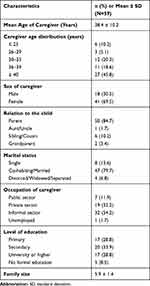 |
Table 1 Socio-Demographic Characteristics of Caregivers |
Socio-Demographic Correlates of NKS Scores and DDS
Socio-demographic correlates of caregivers’ level of type 1 diabetes nutrition knowledge (measured as NKS scores) and child’s dietary diversity (measured as DDS) were examined. Results showed that having no formal education was significantly associated with a lower mean NKS score (p = 0.039) compared to those with primary, secondary, university or higher education. Family size was also significantly positively associated with the child DDS, with children from larger families more likely to have a higher DDS (p = 0.027). The rest of the variables were not found to be significantly associated (Table 2).
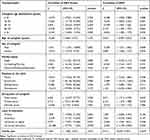 |
Table 2 Socio-Demographic Correlates of Caregivers’ Level of Type 1 Diabetes Nutrition Knowledge and Child’s Dietary Diversity |
Caregiver Nutrition Knowledge Scores
Most of the caregivers (93.2%) scored fifty or less percentage points with a mean NKS score of 30.2 ± 15.4 (Table 3). The NKS domain with the best mean percentage score of correct responses was blood glucose response to food with a score of 66.9 ± 36.6. The second-best response was on healthful eating and third, nutrition label reading (40.0 ± 19.3 and 27.1 ± 27.9, respectively). Carbohydrate counting was the fourth and lowest performed domain (5.7 ± 12.3).
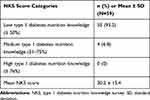 |
Table 3 NKS Categories |
One-way between-groups analysis of variance was conducted to explore the impact of level of education (no formal education, primary, secondary or university or higher) on NKS scores. There was a significant difference between the groups: (F (3, 55) = 4.839, p = 0.005). A Tukey post hoc test showed that there was a significant difference in mean NKS score between those caregivers with no formal education and those that had a primary education (p = 0.014), secondary education (p = 0.011) and university level or higher education (p = 0.002). No significant differences in NKS scores were observed based on sex of caregiver (t-test; p = 0.929) and caregivers age distribution (F (4, 54) = 0.533, p = 0.712).
A one-way ANCOVA was also conducted to explore the impact of the level of education (no formal education, primary, secondary or university or higher) on NKS scores whilst controlling for age of the caregiver and duration of T1D. Normality, linearity, homogeneity of variances, homogeneity of regression slopes and reliable measurement of the covariate’s checks were conducted and none of the assumptions we are violated. There was a statistically significant difference in NKS scores F (3, 52) = 4, p = 0.012, partial eta squared = 0.19. Fisher’s exact test did not show any statistically significant association between level of caregivers type 1 diabetes nutrition knowledge and DDS categorization based on caregivers level of education (Fisher’s exact test, p = 0.564).
Children’s T1D Related Characteristics
The mean age of the children was 9.8 ± 3.2 years with almost equal gender representation. Most (67.8%) of the children had no family history of T1D while those who had a family history had mainly grandparents (52.6%) and siblings or cousins (42.1%) diagnosed with T1D. The highest proportion (57.4%) had T1D for 2–5 years with the majority (67.2%) of the children reporting being on a multiple daily insulin injection regimen (≥3 times a day) (Table 4).
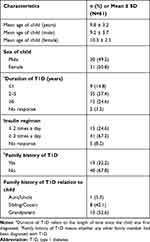 |
Table 4 Children’s T1D Related Characteristics |
Children’s Dietary Intake
The children’s mean DDS and calorie intake were 5.7 ± 1.6 and 1666.7 ± 639.9 kcal, respectively. The majority (75.4%) had a high DDS (≥5). There was no significant difference in DDS for males (5.8 ± 1.5) and females (5.6 ± 1.6) (Mann–Whitney U-test; p = 0.719). The mean daily percent calories from carbohydrates were 68.6 ± 15.4. The mean NARs of carbohydrate, protein, and fat were 0.9 ± 0.3, 0.9 ± 0.4, 0.5 ± 0.5, respectively. Micronutrient adequacy as summarized in Table 5, only vitamin B6 had excess intake with a NAR above 1. Inadequacies were observed with Vitamins A, B1, B2, B3 B5, B12, biotin and folic acid that all had mean NARs below 1. Adequate intake of minerals was observed where, iron and zinc both had a NAR of 1 except calcium that was below 1. The MAR was 0.7 ± 0.3 (Table 5). There was a significant positive correlation between DDS with NARs of carbohydrate, protein, fat, vitamins A, B2, B3, B5, B12, folic acid, zinc and MAR (Table 6). The children’s DDS, intake of macronutrients, MAR and most NARs were not significantly correlated with caregiver’s NKS scores apart from the NARs of folic acid and biotin. Vitamin B12 NAR was positively correlated with caregiver’s NKS scores (Table 7).
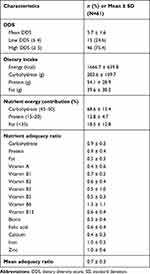 |
Table 5 Children’s Dietary Intake |
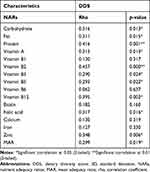 |
Table 6 Correlation Between Dietary Diversity Score and Nutrient Adequacy Ratios, Mean Adequacy Ratio |
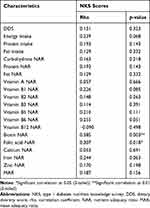 |
Table 7 Correlation Between Caregivers’ Nutrition Knowledge Scores and DDS, Macronutrient Intake, NARs and MAR |
Simple linear regression showed that a unit increase in caregivers’ level of type 1 diabetes nutrition knowledge would lead on average to 0.012 increase in children’s DDS [β = 0.012; 95% CI: 0.018, 0.056]. Caregivers level of type 1 diabetes nutrition knowledge accounted for 1.3% of the variation in the child’s dietary diversity, however, this was not statistically significantly, F (1, 57) = 0.755, p = 0.389 (Table 8).
 |
Table 8 Associations of Dietary Diversity Score and Socio-Demographic, Type 1 Diabetes Nutrition Knowledge and Type 1 Related Characteristics in Simple and Multiple Regression Models |
Multiple linear regression analysis was conducted to determine whether the child’s DDS differed according to caregivers’ type 1 diabetes nutrition knowledge, age and family size. There was a significant relationship between family size and child’s DDS (p = 0.027). However, the relationships between caregivers’ type 1 diabetes nutrition knowledge and child’s DDS (p = 0.108) and caregivers age and child’s DDS (p = 0.425) were not significant. Caregivers’ type 1 diabetes nutrition knowledge, age and family size explained 14% of variation in the child’s dietary diversity. F (3, 54) = 2.950, p = 0.041, R2 = 0.141 (Table 8).
Multiple linear regression also showed that DDS reduced with increased duration of T1D where children who had T1D for a period of 1 year or less were less likely to have a lower dietary diversity score compared to children who had T1D for a period of 6 or more years’ duration. [β = −0.091; 95% CI: −1.714, 7.205]. Furthermore, children who had T1D for a period of 2–5 years were less likely to have a lower dietary diversity score compared to children who had T1D for a period of 6 or more years’ duration. [β = −0.328; 95% CI: −2.019, −0.096; p = 0.032]. However, joint probability showed the duration of T1D was not a significant predictor of DDS (p = 0.083) (Table 8).
Discussion
Children with T1D are dependent on caregivers to supervise and help them implement their diabetes care plan.5 In this study, most of the caregivers were aged 40 years and above. This finding is similar to a study conducted among caregivers of children with diabetes in Poland by Kobos and Imiela27 who reported a mean age of mothers and fathers as 39.6 ± 6.8 and 43.2 ± 7.6 years, respectively. The majority of the caregivers were parents; this finding is similar to that reported by Nuncio-Naud et al28 among Canadian children and adolescents with T1D. It would be important for parents to have adequate knowledge and skills required in management of T1D for effective blood sugar control while supporting optimal growth, development, health and wellbeing. The proportion of type 1 diabetic children with an affected first-degree relative at the time of diagnosis is about 10–12% and this increases with years of follow up. Kyokunzire and Matovu9 reported a familial history of T1D in over 50% of the total study participants at two urban diabetes clinics in Kampala, Uganda. In contrast, the study found that most children in Uganda had no family history of T1D. This probably could be due to lack of accumulative knowledge of disease history in the families that participated in the study.29
Nutritional management of children with T1D requires collaboration with the caregiver whose nutrition knowledge has been associated with improved nutritional outcomes in the child.5 This study found that caregivers had low nutrition knowledge that had a positive association with education level, this finding does not concur with the study by Nuncio-Naud et al28 that reported high nutrition knowledge among parents of children with T1D. Our finding indicates a deficit of T1D nutrition knowledge among caregivers of children with T1D in Uganda especially among those with low education level. The knowledge domain of carbohydrate counting had the lowest mean percentage score despite its significance in management of blood sugar. This finding is in contrast to a study conducted by Smart et al30 that reported caregivers being able to estimate the carbohydrate content of meals with reasonable accuracy. The finding highlights the main nutrition knowledge gap that needs to be addressed among caregivers as they probably lack adequate knowledge on carbohydrate counting and therefore less likely to correctly estimate the carbohydrate content of their children’s diet.31 Nutrition knowledge on healthy eating and nutrition label readings were also poorly performed. There was negative association between education level and NKS scores where caregivers with no formal education were more likely to have lower scores compared to educated counterparts. This finding is in agreement with Moskovitz et al32 who reported lower levels of parent education being associated with a lower probability of adequate diabetes knowledge. Our finding implies that caregivers with low formal education are probably less likely to acquire and process nutrition knowledge and should be targeted with innovative methods to enhance learning and knowledge retention.33
Maternal nutrition knowledge has been positively associated with children’s diet34–37 since, caregivers play significant role in shaping the principles of rational nutrition among their children.38 This study did not find significant associations between caregivers’ NKS scores and children’s DDS, mean intake of macronutrients as we had hypothesized.39 This could be attributed to the low mean knowledge score among the caregivers indicating a general poor knowledge level. Another possible explanation for our finding is that most of the diabetes education programs for children and adolescents with TID in Uganda40–42 often do not include their caregivers. This implies that caregivers possibly do not get adequate knowledge on how to positively manage their children’s diabetes and this consequently may contribute to the disconnect between their level of nutrition knowledge and their children’s dietary practices. Despite the lack of statistical significance adequate nutrition knowledge is still vital in ensuring that caregivers help their children adhere to multiple diabetes-related tasks.7,10
The nutritional principles of feeding children and adolescents with T1D do not differ from those of their non-diabetic counterparts.38 In addition, consuming a diverse diet can help children and adolescents with T1D meet their nutritional requirements and development milestones.37 Analysis of the children’s dietary intake data revealed a high carbohydrate intake that is similar to what was reported by Folsom and Hannon43 in a study conducted among adolescents with T1D. However, Folsom and Hannon also reported higher protein and fat intake. The dietary intake of children and adolescents with T1D should contribute approximately 45–50% of energy from carbohydrates, fat less than 35% of energy and protein 15–20% of energy.26 This study found that the children and adolescents’ energy proportion of macronutrients exceeded the International Society of Pediatric and Adolescent Diabetes (ISPAD) recommended ranges with high carbohydrate intake and low protein and fat intake.26 This finding is in disagreement with Seckold et al44 who reported energy proportion of macronutrients that were within the ISPAD recommended ranges among Australian children with T1D. Children with T1D in Uganda may be consuming excess carbohydrates with inadequate intake of proteins and fats45 and the discrepancies should be addressed in targeted interventions for optimal nutrient intake.
Vitamins B1, B2, B3 B5, B12, biotin, and folic acid are some of the B complex vitamins that play significant roles in cellular functioning, acting as co-enzymes in enzymatic reactions. This study findings indicate that the children’s dietary intake was deficient in comparison with recommended nutrient intakes. This increases the risk to sub-optimal neurological and physiological functioning of the body.46 Furthermore, inadequate folic acid intake has been related to endothelial dysfunction which is a risk factor to the development of atherosclerosis later in life among children with T1D.47 Vitamin A intake also was low with the children consuming only 40% of the RDA confirming that that vitamin A deficiency remains prevalent in Uganda48 despite its vital role in maintaining healthy vision, and the immune system. This study also found calcium intake was below the RDA that is in agreement with a systematic review by Patton49 who reported similar findings. Calcium plays a significant role in promoting good bone health, therefore low calcium intake could contribute to poor bone development due to low bone mineral density increasing the children’s risk of osteoporotic fractures.
The current study found that the majority of the children had a DDS of greater than 4, this is higher than a DDS of 3.8 reported in a study conducted among South African children by Steyn et al,20 despite similarities in carbohydrate, protein and fat energy contribution in the diet. This study finding signifies a favourable dietary diversity among the children with T1D in Uganda that could have attributed to favorable mean adequacy ratio among the children who met 90% of the RDA of carbohydrate and protein. However, low fat intake was observed where the children only met 50% of the RDA which puts them at risk of essential fatty acid deficiencies.50 There was a significant positive association between DDS with NARs of carbohydrate, fat, protein, folic acid, biotin, zinc, vitamins A, B2, B3, B5, B12 and MAR. This is similar to a study by Mirmiran et al25 conducted among adolescents in which it reported a significant association between DDS and most of the NARs. In the same study, DDS was also positively correlated with MAR. These findings indicate that improving DDS positively influences nutrient adequacy.
The current study found that caregivers’ T1D nutrition knowledge level, age and family size jointly predicted children’s DDS, these findings are further corroborated by studies conducted in Ghana and Tanzania that found caregiver nutrition knowledge and household/family size predicted dietary diversity.37,51 Children who had T1D for periods of 1 year or less and 2–5 years were less likely to have a lower dietary diversity score compared to children who had T1D for a period of 6 or more years. This finding is consistent with Chisholm et al,52 who also reported longer T1D duration to be correlated with poorer dietary adherence. This finding suggests the need for repeated nutrition education input for caregivers of type 1 diabetic children in order to ensure sustained adherence to dietary recommendations.
Strengths and Limitations
One of the limitations of this study is the design that was cross-sectional with a small consecutively recruited sample. In addition, the study relied on caregivers’ dietary recall, which may be subject to recall bias, however interviewer training and cross-validation were conducted to minimize recall bias. Furthermore, the study only assessed nutrition knowledge and dietary intake at a point in time, a longitudinal study would be an ideal study design to compare caregiver’s nutrition knowledge and children’s dietary intake over different seasons in time. However, the study identified the caregiver’s knowledge deficits and areas that should be focused on in relation to interventions such as nutrition education. Also, the findings may serve as preliminary evidence to help inform larger studies to further examine the nutrition knowledge of caregivers of children with T1D in a sub-Saharan setting.
Conclusion
Overall children with T1D in Uganda have favorable dietary diversity. However, excess carbohydrate intake was observed with an inadequate intake of proteins and fats. Additionally, there was inadequate intake of B vitamins, vitamin A and calcium. There may be need to examine the individual types of food consumed by children with T1D in order to identify food selection considerations that may be contributing to the inadequate intake of micronutrients, proteins and fats. In addition, caregiver’s had low nutrition knowledge levels, particularly in carbohydrate counting. Caregivers with no formal education were more likely to have lower nutrition knowledge scores compared to educated counterparts. Therefore, caregiver nutrition education interventions should be designed to address the needs of this particular sub‐group of caregivers.
Acknowledgments
We would like to thank the staff of Nsambya, Mulago, Virika, Lubaga, Holy Innocents children’s hospitals and Wakiso health center IV for their cooperation and support. We would also wish to thank the research assistants for their valuable help in data collection. Most importantly, we extend our sincere gratitude to all the families that participated in this study.
Author Contributions
All authors made a significant contribution to the work reported, whether that is in the conception, study design, execution, acquisition of data, analysis and interpretation, or in all these areas; took part in drafting, revising or critically reviewing the article; gave final approval of the version to be published; have agreed on the journal to which the article has been submitted; and agree to be accountable for all aspects of the work.
Funding
This study was supported by a grant from the Kyambogo University African Development Bank Higher Education Science and Technology Project (Uganda). However, the design, analysis, and reporting of the results are independent of the funder.
Disclosure
The authors report no conflicts of interest in this work.
References
1. International Diabetes Federation. IDF Diabetes Atlas.
2. Bahendeka S, Mutungi G, Tugumisirize F, et al. Healthcare delivery for paediatric and adolescent diabetes in low resource settings: type 1 diabetes clinics in Uganda. Glob Public Health. 2019;1–15.
3. Rankin D, Harden J, Jepson R, Lawton J. Children’s experiences of managing Type 1 diabetes in everyday life: a thematic synthesis of qualitative studies. Diabetic Med. 2017;34(8):1050–1060. doi:10.1111/dme.13362
4. Bahendeka SK. Diabetes in sub-Saharan Africa: let us not forget type 1. Lancet Diabetes Endocrinol. 2017;5(8):575–577. doi:10.1016/S2213-8587(17)30223-1
5. Rosolowsky E, Yaskina M, Couch R. Pediatric type 1 diabetes: patients’ and caregivers’ perceptions of glycemic control. Can J Diabetes. 2018;42(3):302–7.e1. doi:10.1016/j.jcjd.2017.07.002
6. Haslund-Thomsen H, Hasselbalch LA, Laugesen B. Parental experiences of continuous glucose monitoring in Danish children with type 1 diabetes mellitus. J Pediatr Nurs. 2020;53:e149–e155. doi:10.1016/j.pedn.2020.03.010
7. Ogle G, Middlehurt A, Silink M, Hanas R. Pocketbook for Management of Diabetes in Childhood and Adolescence in Under-Resourced Countries.
8. Speight J, Bradley C. The ADKnowl: identifying knowledge deficits in diabetes care. Diabet Med. 2001;18(8):626–633. doi:10.1046/j.1464-5491.2001.00537.x
9. Kyokunzire C, Matovu N. Factors associated with adherence to diabetes care recommendations among children and adolescents with type 1 diabetes: a facility-based study in two urban diabetes clinics in Uganda. Diabetes Metabol Syndr Obes. 2018;11:93–104. doi:10.2147/DMSO.S156858
10. Noorani M, Ramaiya K, Manji K. Glycaemic control in type 1 diabetes mellitus among children and adolescents in a resource limited setting in Dar es Salaam - Tanzania. BMC Endocr Disord. 2016;16:29. doi:10.1186/s12902-016-0113-y
11. Chege PM, Kuria EN. Relationship between nutrition knowledge of caregivers and dietary practices of children under five in Kajiado County, Kenya. Womens Health Bull. 2017;4(3). doi:10.5812/whb.43820
12. Nti CA, Lartey A. Effect of caregiver feeding behaviours on child nutritional status in rural Ghana. Int J Consum Stud. 2007;31(3):303–309. doi:10.1111/j.1470-6431.2006.00553.x
13. Beck JK, Cogen FR. Outpatient management of pediatric type 1 diabetes. J Pediatr Pharmacol Therap. 2015;20(5):344–357. doi:10.5863/1551-6776-20.5.344
14. Ndahura NB, Munga J, Kimiywe J, Mupere E. Effectiveness of a nutrition education package on glycaemic control among children with type 1 diabetes mellitus aged 3–14 years in Uganda: study protocol for a cluster-randomized trial. medRxiv. 2020.
15. Rovner AJ, Nansel TR, Mehta SN, Higgins LA, Haynie DL, Laffel LM. Development and validation of the type 1 diabetes nutrition knowledge survey. Diabetes Care. 2012;35(8):1643–1647. doi:10.2337/dc11-2371
16. Gibson RS, Charrondiere UR, Bell W. Measurement errors in dietary assessment using self-reported 24-hour recalls in low-income countries and strategies for their prevention. Adv Nutr. 2017;8(6):980–991. doi:10.3945/an.117.016980
17. Kyamuhangire W, Lubowa A, Kaaya A, et al. The importance of using food and nutrient intake data to identify appropriate vehicles and estimate potential benefits of food fortification in Uganda. Food Nutr Bull. 2013;34(2):131–142. doi:10.1177/156482651303400202
18. FAO. Guidelines for Measuring Household and Individual Dietary Diversity. In: Gina K, Terri B, MarieClaude D, editors. Rome: FAO; 2013.
19. Kennedy G, Nantel G. Basic Guidelines for Validation of a Simple Dietary Diversity Score as an Indicator of Dietary Nutrient Adequacy for Non-Breastfeeding Children 2–6 Years. Rome: FAO; 2006.
20. Steyn NP, Nel J, Labadarios D, Maunder EMW, Kruger HS. Which dietary diversity indicator is best to assess micronutrient adequacy in children 1 to 9 y? Nutrition. 2014;30(1):55–60. doi:10.1016/j.nut.2013.06.002
21. Caswell BL, Talegawkar SA, Siamusantu W, West KP, Palmer AC. A 10-food group dietary diversity score outperforms a 7-food group score in characterizing seasonal variability and micronutrient adequacy in Rural Zambian Children. J Nutr. 2018;148(1):131–139. doi:10.1093/jn/nxx011
22. IBM Corp. IBM SPSS Statistics for Macintosh, Version 26.0. Armonk, NY: IBM Corp; 2019.
23. Hotz C, Abdelrahman L, Sison C, Moursi M, Loechl C. A Food Composition Table for Central and Eastern Uganda. Washington, DC: International Food Policy Research Institute and International Center for Tropical Agriculture; 2012.
24. Steyn NP, Nel JH, Nantel G, Kennedy G, Labadarios D. Food variety and dietary diversity scores in children: are they good indicators of dietary adequacy? Public Health Nutr. 2007;9(5):644–650. doi:10.1079/PHN2005912
25. Mirmiran P, Azadbakht L, Esmaillzadeh A, Azizi F. Dietary diversity score in adolescents-a good indicator of the nutritional adequacy of diets: Tehran lipid and glucose study. Asia Pac J Clin Nutr. 2004;13(1):56–60.
26. Smart CE, Annan F, Higgins LA, Jelleryd E, Lopez M, Acerini CL. ISPAD clinical practice consensus guidelines 2018: nutritional management in children and adolescents with diabetes. Pediatr Diabetes. 2018;19(S27):136–154. doi:10.1111/pedi.12738
27. Kobos E, Imiela J. Factors affecting the level of burden of caregivers of children with type 1 diabetes. Appl Nurs Res. 2015;28(2):142–149. doi:10.1016/j.apnr.2014.09.008
28. Nuncio-Naud C, Parenteau M, Lafrance G, Rottembourg D. Nutrition knowledge in children with type 1 diabetes and their parents. J Diabetes Treat. 2018;10:2574–7568.
29. Parkkola A, Härkönen T, Ryhänen SJ, Ilonen J, Knip M. Extended family history of type 1 diabetes and phenotype and genotype of newly diagnosed children. Diabetes Care. 2013;36(2):348–354. doi:10.2337/dc12-0445
30. Smart CE, Ross K, Edge JA, King BR, McElduff P, Collins CE. Can children with Type 1 diabetes and their caregivers estimate the carbohydrate content of meals and snacks? Diabetic Med. 2010;27(3):348–353. doi:10.1111/j.1464-5491.2010.02945.x
31. Bandura A. Health promotion by social cognitive means. Health Educ Behav. 2004;31(2):143–164. doi:10.1177/1090198104263660
32. Moskovitz A, Alex Knee M, Frydman E, Allen H, Tonyushkina K. Diabetes knowledge in youth with T1DM and their caregivers-a cross-sectional study. J Diabetes Clin Prac. 2018;1(1):101.
33. Ayyagari P, Grossman D, Sloan F. Education and health: evidence on adults with diabetes. Int J Health Care Finance Econ. 2011;11(1):35–54. doi:10.1007/s10754-010-9087-x
34. Gibson EL, Wardle J, Watts CJ. Fruit and vegetable consumption, nutritional knowledge and beliefs in mothers and children. Appetite. 1998;31(2):205–228. doi:10.1006/appe.1998.0180
35. Blaylock J. Maternal Nutrition Knowledge and Children’s Diet Quality and Nutrient Intakes. US Department of Agriculture, Economic Research Service; 1999.
36. Oduor FO, Boedecker J, Kennedy G, Mituki-Mungiria D, Termote C. Caregivers’ nutritional knowledge and attitudes mediate seasonal shifts in children’s diets. Matern Child Nutr. 2019;15(1):e12633. doi:10.1111/mcn.12633
37. Christian AK, Marquis GS, Colecraft EK, et al. Caregivers’ nutrition knowledge and attitudes are associated with household food diversity and children’s animal source food intake across different agro-ecological zones in Ghana. Br J Nutr. 2016;115(2):351–360. doi:10.1017/S0007114515004468
38. Mankiewicz-Zurawska I, Jarosz-Chobot P. Nutrition of children and adolescents with type 1 diabetes in the recommendations of the Mediterranean diet. Pediatr Endocrinol Diabetes Metab. 2019;25(2):74–80. doi:10.5114/pedm.2019.85817
39. Variyam JN, Blaylock J, Lin BH, Ralston K, Smallwood D. Mother’s nutrition knowledge and children’s dietary intakes. Am J Agric Econ. 1999;81(2):373–384. doi:10.2307/1244588
40. Colavito EA, Guthrie JF, Hertzler AA, Webb RE. Relationship of diet-health attitudes and nutrition knowledge of household meal planners to the fat and fiber intakes of meal planners and preschoolers. J Nutr Educ. 1996;28(6):321–328. doi:10.1016/S0022-3182(96)70121-8
41. Dehayem MY, Takogue R, Choukem SP, et al. Impact of a pioneer diabetes camp experience on glycemic control among children and adolescents living with type 1 diabetes in sub-Saharan Africa. BMC Endocr Disord. 2016;16:5. doi:10.1186/s12902-016-0086-x
42. Kabeza CB, Kanagasabai T, Kateera BA, Gishoma C, Hobabagabo A, El-Khatib Z. The impact of educational camp on glycemic control of Rwandan type 1 diabetes youth. Rwanda J Med Health Sci. 2019;2(1):21–24. doi:10.4314/rjmhs.v2i1.4
43. Folsom LJ, Hannon TS. Impact of nutrition knowledge, dietary composition, and eating behaviors in adolescents with type 1 diabetes: a prospective, longitudinal study. Top Clin Nutr. 2020;35(2):144–153. doi:10.1097/TIN.0000000000000203
44. Seckold R, Howley P, King BR, Bell K, Smith A, Smart CE. Dietary intake and eating patterns of young children with type 1 diabetes achieving glycemic targets. BMJ Open Diabetes Res Care. 2019;7(1):e000663. doi:10.1136/bmjdrc-2019-000663
45. Smart CE, Annan F, Bruno LP, et al. ISPAD clinical practice consensus guidelines 2014. Nutritional management in children and adolescents with diabetes. Pediatr Diabetes. 2014;15(Suppl 20):135–153. doi:10.1111/pedi.12175
46. Kennedy DO. B vitamins and the brain: mechanisms, dose and efficacy—a review. Nutrients. 2016;8(2):68. doi:10.3390/nu8020068
47. MacKenzie KE, Wiltshire EJ, Gent R, Hirte C, Piotto L, Couper JJ. Folate and vitamin B6 rapidly normalize endothelial dysfunction in children with type 1 diabetes mellitus. Pediatrics. 2006;118(1):242–253. doi:10.1542/peds.2005-2143
48. Hotz C, Loechl C, Lubowa A, et al. Introduction of β-carotene–rich orange sweet potato in Rural Uganda resulted in increased vitamin a intakes among children and women and improved vitamin A status among children. J Nutr. 2012;142(10):1871–1880. doi:10.3945/jn.111.151829
49. Patton SR. Adherence to diet in youth with type 1 diabetes. J Am Diet Assoc. 2011;111(4):550–555. doi:10.1016/j.jada.2011.01.016
50. Cheung ST. Possible dangers in a low fat diet: some evidence reviewed. Nutr Health. 2000;14(4):271–280. doi:10.1177/026010600001400408
51. Powell B, Bezner Kerr R, Young SL, Johns T. The determinants of dietary diversity and nutrition: ethnonutrition knowledge of local people in the East Usambara Mountains, Tanzania. J Ethnobiol Ethnomed. 2017;13(1):23. doi:10.1186/s13002-017-0150-2
52. Chisholm V, Atkinson L, Donaldson C, Noyes K, Payne A, Kelnar C. Predictors of treatment adherence in young children with type 1 diabetes. J Adv Nurs. 2007;57(5):482–493. doi:10.1111/j.1365-2648.2006.04137.x
 © 2021 The Author(s). This work is published and licensed by Dove Medical Press Limited. The full terms of this license are available at https://www.dovepress.com/terms.php and incorporate the Creative Commons Attribution - Non Commercial (unported, v3.0) License.
By accessing the work you hereby accept the Terms. Non-commercial uses of the work are permitted without any further permission from Dove Medical Press Limited, provided the work is properly attributed. For permission for commercial use of this work, please see paragraphs 4.2 and 5 of our Terms.
© 2021 The Author(s). This work is published and licensed by Dove Medical Press Limited. The full terms of this license are available at https://www.dovepress.com/terms.php and incorporate the Creative Commons Attribution - Non Commercial (unported, v3.0) License.
By accessing the work you hereby accept the Terms. Non-commercial uses of the work are permitted without any further permission from Dove Medical Press Limited, provided the work is properly attributed. For permission for commercial use of this work, please see paragraphs 4.2 and 5 of our Terms.
